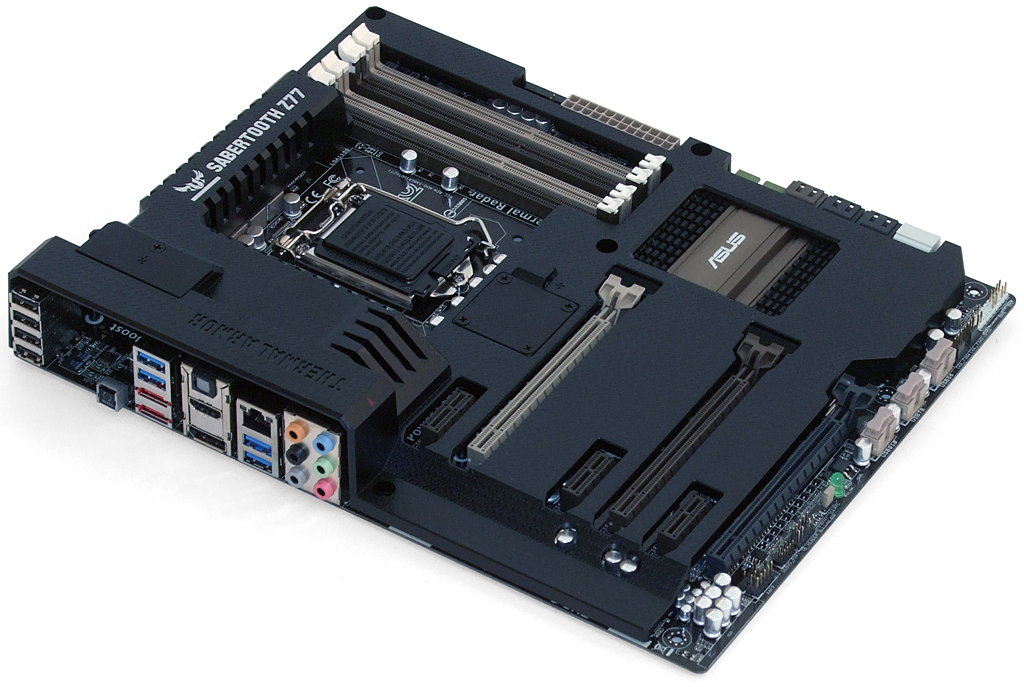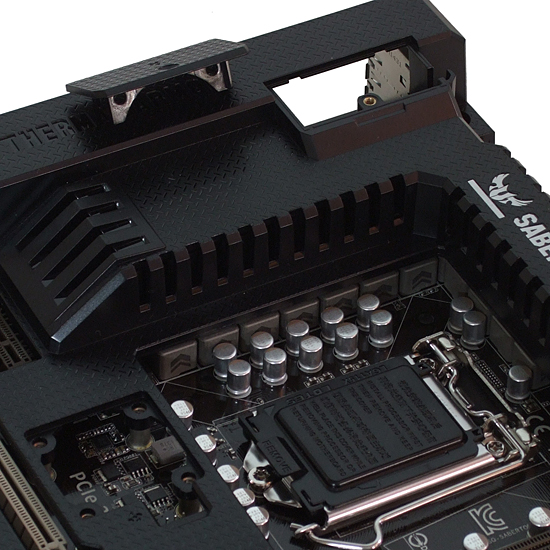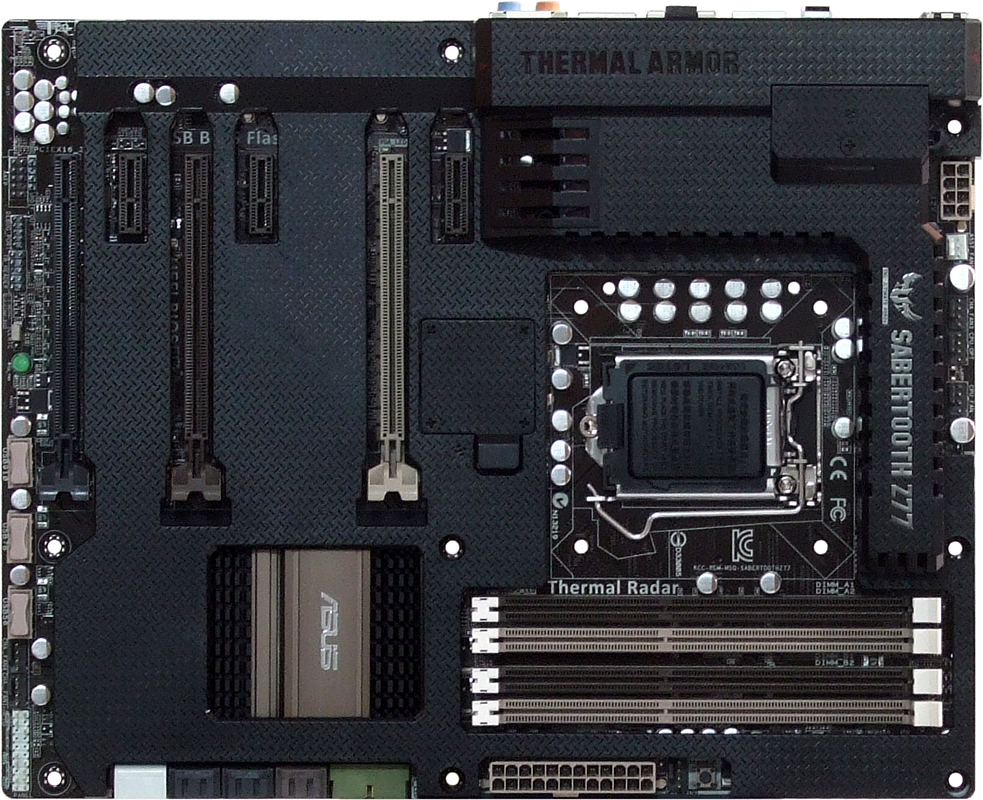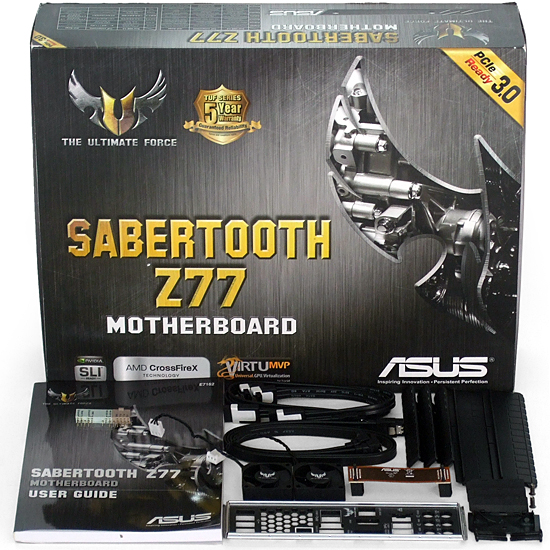Six $220-280 Z77 Express-Based Motherboards, Reviewed
Expanded graphics card support, enhanced on-board features that include Thunderbolt on some models, and more-robust voltage control are all good reasons to consider paying a little extra for a higher-end motherboard. Today we examine five top choices.
Asus Sabertooth Z77
Asus gives its Sabertooth Z77 the stealth treatment with a plastic cover that hides most of its on-board components. Users who don’t even want their empty slots to show will find even more covers inside the box.
The Sabertooth Z77’s I/O-panel looks surprisingly sparse in light of its specifications list, but that’s simply because Asus gets rid of large and often-unused connectors like PS/2 and DVI. We still find two eSATA connectors back there, in addition to four USB 3.0 and four USB 2.0 ports, DisplayPort, HDMI, and Asus' support-simplifying USB BIOS Flashback button.
Anyone worried about heat getting trapped under those covers can remove two sections and install a pair of bundled 40 mm fans. The coolers operate almost silently in automatic mode, though manually configuring them to spin at full speed generate moderate noise.
All eight internal SATA ports face forward, along with the internal USB 3.0 header, making room for up to three graphics card of any length. Though forward-facing ports were occasionally blocked by the lower drive cage of older cases, that problem rarely affects new builds. Asus addresses the more recent deficiency of some case designs unable to reach front-panel audio headers by moving the Sabertooth Z77’s own connector forward from its traditional bottom-rear-corner by about an inch.
The large cover blanketing Asus' board probably limited fan header placement to the motherboard’s edges. We see four connectors up top, one on the front, and two at the bottom. Two additional headers under the cover connect the optional 40 mm intake and exhaust fans.
Asus’ Sabertooth boards are designed to be shown off, but that doesn’t necessarily make them part of the company's gamer/enthusiast marketing push. None of its Sabertooth products show up on the Republic of Gamers site, and the board doesn’t have the expensive PLX switch that would have enabled three-way SLI. Instead, the top two slots share sixteen PCIe 3.0 lanes, with auto-switching setting x16/x0 and x8/x8 modes. The third slot gets a maximum of four PCIe 2.0 lanes from the PCH. Three of those lanes must be taken from the x1 slots manually, as Asus' firmware defaults the third graphics slot to x1 mode.
Because it's a two-way SLI design, Asus’ Sabertooth Z77 includes a single SLI bridge, along with four SATA cables, two optional cooling fans, and several slot covers.
Get Tom's Hardware's best news and in-depth reviews, straight to your inbox.
Current page: Asus Sabertooth Z77
Prev Page Z77 OC Formula Firmware Next Page Sabertooth Z77 Software-
roberta As u have reviewed SIX (6) motherboards, the article's title should be:Reply
"Six $220-280 Z77 Express-Based Motherboards, Reviewed" -
mayankleoboy1 No SATA and USB tests ? data transfer speed differences will typically be noticable in everyday usage.Reply
Also, the time taken to show the windows loading screen/ BIOS page.. -
admit it.Reply
you really liked the black/grey dimms and PCI slots of the gigabyte better than the blue/black of the MSI! -
Crashman robertaAs u have reviewed SIX (6) motherboards, the article's title should be:"Six $220-280 Z77 Express-Based Motherboards, Reviewed"Let's see what the article says:ReplyThe one motherboard in today’s line-up with a 48-lane PCIe 3.0 bridge is ECS’ Golden Z77H2-AX. Unfortunately, this platform climbed $40 beyond the budget limit of today’s round-up in the time we've been reviewing it. We're tired of seeing board vendors playing pricing games based on our review schedule (this isn't the first time we're seeing a curiously-timed price move). So, since we put the work in to review ECS' submission, we're including our already-gathered data and simply withholding the board from any award candidacy.
mayankleoboy1No SATA and USB tests ? data transfer speed differences will typically be noticable in everyday usage.Also, the time taken to show the windows loading screen/ BIOS page..Would have covered windows load time except that it wasn't markedly different. That is, after disabling empty SATA controllers. If you count the time that it takes to get the "No Device Found" error on boards that have extra SATA controllers, you're penalizing a board for having more features.
Andrew Ku tests drive controllers. I'm trying to get him to "write the book" on controller performance, since dozens of boards use only a few different controllers. As for testing things like Z77 controller performance on board A vs Z77 controller performance on board B, it's a waste of time unless something is broken. So the article looked for "broken stuff". See the red bar on the first chart:
http://www.tomshardware.com/reviews/z77x-up5-th-z77a-gd80-z77-oc-formula,3305-22.html
With nothing broken, there's no excuse to test the Z77 controller six times. Back to me begging Andrew Ku for a comprehensive comparison of every SATA controller currently available on mainstream-brand enthusiast boards.
-
JeanLuc Arghh! Why the hell are you overclocking the base clock on Z77!! That will most likely cause permanent damage to your CPU.Reply -
You left out a key aspect for overclockers which is vcore offset.Reply
This allows ocer's to achieve higher overclocks while still retaining the power saving functions, instead of being forced to either reduce the overclock, or be forced to run high voltage 24/7.
MSI doesn't have this key feature. -
Onus I would think that the Sabertooth's five year warranty merits at least a mention in any value conclusion.Reply
-
luciferano JeanLucArghh! Why the hell are you overclocking the base clock on Z77!! That will most likely cause permanent damage to your CPU.Reply
Overclocking the BLCK is very unlikely to cause any damage, it's just likely to not give much of a stable overclock. -
Crashman jtt283I would think that the Sabertooth's five year warranty merits at least a mention in any value conclusion.I actually missed that, having checked the lesser brands just to make sure those still had their three year warranty. Will add it.Reply




